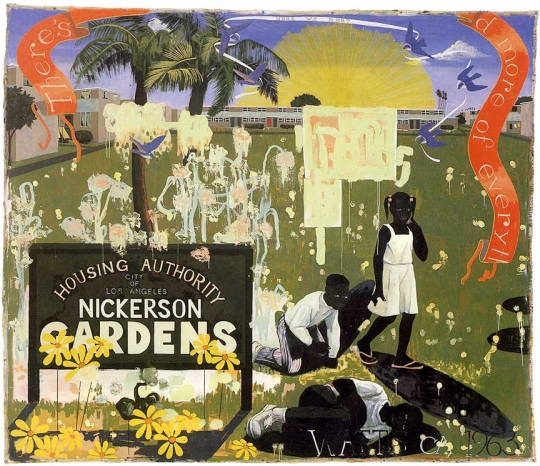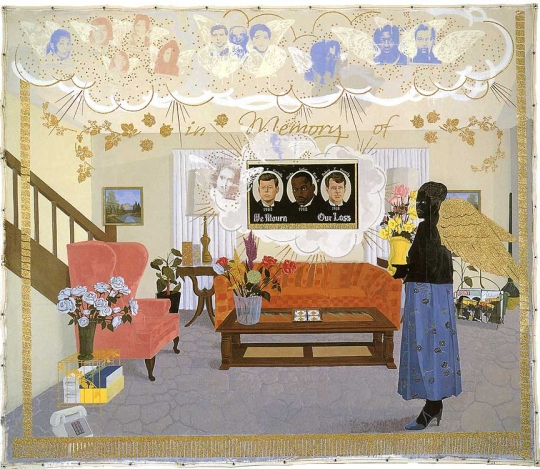
Kerry James Marshall. Many Mansions, 1994. Acrylic and collage on unstretched canvas; 114 x 135 inches. Art Institute of Chicago, Max V. Kohnstamm Fund, 1995. Courtesy Jack Shainman Gallery, New York.
This previously unpublished text has been excerpted from an interview conducted with artist Kerry James Marshall in 2014 for the Artist to Artist film “Kerry James Marshall at Prospect 3.”
Art21: What about the art historical tradition drives your work?
Kerry James Marshall: Currently, the way the narrative of art history is framed, the privileged body is a white body. And because that’s the Italian Renaissance body, the Western European body, that’s where the tradition of art history as we understand it, comes from. That’s what we understand to be the ideals of beauty, ideals of grace, ideals of form, all those things. And so, a part of what I’m doing is making work that functions in those same capacities, but that centralizes the Black figure. So that’s in the paintings I make, and in a lot of the photography I do.
Art21: While we were driving around New Orleans yesterday, you mentioned how predominantly Black communities around the nation have shared situations. Could you elaborate?
KJM: The Black population as a cultural body is generally undercapitalized. And so when you find large concentrations of Black people in communities, most of those communities are undercapitalized, from undercapitalized to impoverished. And so there’s a way in which this idea of impoverishment becomes associated with the idea of Black people.
And so when I go from city to city, from state to state, it’s not really hard to detect where the boundaries of the traditional Black communities are, and where the boundaries of what we call traditionally White communities are, because there’s a distinct transformation that takes place across that boundary where you can see that the economic level of comfort drops, fairly dramatically in a lot of Black communities. I’m acutely aware of those transitions, acutely aware of where those boundaries seem to be.
There’s a notion that comes out of the end of Jim Crow and segregation, this idea that in part was the formulation of the Brown decision, in Brown vs. the Board of Education, that separate is inherently unequal. And you really have to look at what that means. Because what that says is not that separate is inherently unequal across the board, but separate is inherently unequal for Black people.
Because Black people in communities that are separated from what we call the mainstream don’t have anywhere near the same sort of economic capacity, the economic infrastructure, the foundation, that White communities have. So White communities could be separate and they do quite well. But Black communities that are separated don’t do so well. And so what that tends to do is reinforce the idea that there’s something inherently problematic about Black people. And you have to have an answer as to why that separation doesn’t adversely affect the White population, as it affects the Black population. And that means that you have to look at the historical relationship between these two populations in a way that I think the simple construction of that phrase, “separate is inherently unequal,” doesn’t do.

Kerry James Marshall. Watts 1963, 1995. Acrylic and collage on unstretched canvas, 114 x 135 inches. St. Louis Museum of Art, Museum Minority Artists Purchase Fund. Courtesy Jack Shainman Gallery, New York.
Art21: How have you addressed this issue of racial separation in the art world?
KJM: If I went to the LA County Museum of Art to see artwork, I wanted to be in there too, I didn’t want to just keep going looking at other people’s stuff. I mean it’s as simple as that. And once I decided that’s where I wanted to be, I had to try to figure out a strategy for making sure I could get there. It’s almost that simple. And it was based on understanding what I thought the people who were running places like that, figuring out what their expectations were, what they thought they knew, and what they thought was important. And then trying to figure out a way to get what I wanted, while at the same time satisfying what I thought were the interests of the people who were operating at that level.
I mean, that’s how I operate. I look at a destination, I try to map out a strategy, and I try to do the work that I think will meet the expectations—my expectations and their expectations. Because when you’re making artworks you’re not just making artworks for yourself, you’re making artworks because they fit into a narrative structure that purports to define what kinds of things have value.
Art21: It seems like the future and looking to the future is a big part of your work.
KJM: Well for me it is, because I think what seems to be in short supply in the realm of Black representation, is a kind of space in which the imaginary for the future is available to take place…There’s something about that space that I think really encourages a kind of, flight of fancy, a kind of speculation, dreaminess, you know something like that.
Art21: Can you talk more about your interest in history and it’s connection to the future? It sounds like you might not be as interested in history as other artists, or maybe we’ve just talked about it too much?
KJM: Well I think I’ve done my thing for history. I’ve been interested in history for a long time. And I still am. But there’s a funny way in which once you make a certain kind of peace with the past, then you are now on a platform that should be completely oriented towards speculation about the future. Because what you’ve got to be able to do is imagine a future in which you are not just a passenger on a runaway vehicle into the future, but you are driving the future, you know. That you’re deciding what kinds of things ought to be in the future, as opposed to waiting to see how somebody else has decided to shape these things that you’re supposed to have access to in the future.
So, there has to be a moment in which you take this dramatic—and I’m starting to sound like Mao Tse-tung—leap forward.
Because for generations of young people, they have to see it as a possibility. So they can start using their minds to further imagine it. If you don’t see it as a possibility, if you’re constantly being reminded of the ways in which your history and your narrative are kind of rooted in loss and absence and decay or rootlessness, if everything you do seems to cycle back to that as your origin story, then I think you’re in deep trouble, as a people.
I’m not talking about individuals so much as I’m talking about as a people, because when the Black population arrived in the United States, they didn’t arrive as individuals, they arrived as an enslaved people. And the truth is that only as a people, within the context of the United States, can you actually really begin to formulate some sense of one’s self as a liberated entity.

Kerry James Marshall. Souvenir II, 1997. Acrylic, paper, collage, and glitter on unstretched canvas, 108 x 120 inches. Addison Gallery of American Art, Phillips Academy, Andover, Massachusetts. Courtesy Jack Shainman Gallery, New York.
Art21: What has been your experience with the political system in this country?
KJM: Earlier on, when I was first old enough to vote, I registered as an Independent. But when I went to vote in the primaries, I realized the system was structured in such a way that if you registered as an Independent, you got a ballot that only had Independent candidates on it. That you couldn’t split your vote across party lines and vote for whoever you wanted to, you were limited to voting for the person of the party that you had registered for. That was a wakeup call. And that to me it seemed like the system was fixed, it was sort of rigged.
And from that moment, I lost complete faith in the electoral political system in the United States, because I knew it’s not about choice, really. You don’t get to vote the way you want to vote, especially in that first phase, because the system is set up to perpetuate the two party system with Democrats and Republicans. And so that affected me a lot, it changed the way I approached voting from that moment on.
That was 1980 I think, but in 2001 in the run-up to the war in Iraq, when there was a lot of opposition to America launching that invasion in Iraq and people around the world were marching by the millions in the streets. I heard at a news conference once during that period, George Bush said something like ‘Isn’t it wonderful to see people out there exercising their First Amendment right to protest in the streets. But that has nothing to do with any of the decisions we are going to make.’ And in that moment, it became crystal clear how useless, to me, that kind of activity turned out to be. And so, at that moment, the reality of what your responsibility is and how you engage with the social and political and economic realities of your country became really clear to me.
And if I thought earlier on that you had to start to develop a strategic relationship to your environment, I was certain you had to have a strategic relationship to the environment after that. Because it just became clear that you can’t count on anybody else to behave properly. Your wellbeing can’t depend on somebody else behaving well, so I just changed my whole orientation to a lot of things as a result of that.
I started to recognize that the first principle of psychological wellbeing is not requiring a transformation in somebody else, in order for you to realize your objectives. That’s the first principle of psychological wellbeing: That you can’t make somebody else behave well before you can do what you’ve got to do.



